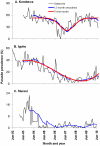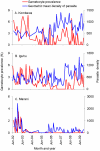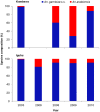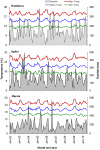Changing patterns of malaria epidemiology between 2002 and 2010 in Western Kenya: the fall and rise of malaria
- PMID: 21629783
- PMCID: PMC3100336
- DOI: 10.1371/journal.pone.0020318
Changing patterns of malaria epidemiology between 2002 and 2010 in Western Kenya: the fall and rise of malaria
Abstract
Background: The impact of insecticide treated nets (ITNs) on reducing malaria incidence is shown mainly through data collection from health facilities. Routine evaluation of long-term epidemiological and entomological dynamics is currently unavailable. In Kenya, new policies supporting the provision of free ITNs were implemented nationwide in June 2006. To evaluate the impacts of ITNs on malaria transmission, we conducted monthly surveys in three sentinel sites with different transmission intensities in western Kenya from 2002 to 2010.
Methods and findings: Longitudinal samplings of malaria parasite prevalence in asymptomatic school children and vector abundance in randomly selected houses were undertaken monthly from February 2002. ITN ownership and usage surveys were conducted annually from 2004 to 2010. Asymptomatic malaria parasite prevalence and vector abundances gradually decreased in all three sites from 2002 to 2006, and parasite prevalence reached its lowest level from late 2006 to early 2007. The abundance of the major malaria vectors, Anopheles funestus and An. gambiae, increased about 5-10 folds in all study sites after 2007. However, the resurgence of vectors was highly variable between sites and species. By 2010, asymptomatic parasite prevalence in Kombewa had resurged to levels recorded in 2004/2005, but the resurgence was smaller in magnitude in the other sites. Household ITN ownership was at 50-70% in 2009, but the functional and effective bed net coverage in the population was estimated at 40.3%, 49.4% and 28.2% in 2010 in Iguhu, Kombewa, and Marani, respectively.
Conclusion: The resurgence in parasite prevalence and malaria vectors has been observed in two out of three sentinel sites in western Kenya despite a high ownership of ITNs. The likely factors contributing to malaria resurgence include reduced efficacy of ITNs, insecticide resistance in mosquitoes and lack of proper use of ITNs. These factors should be targeted to avoid further resurgence of malaria transmission.
Conflict of interest statement
Figures






References
-
- World Health Organization. Geneva 2008: WHO; 2008. World Malaria Report 2008.
-
- World Health Organization. Geneva: Switzerland; 2009. World Malaria Report 2009.

